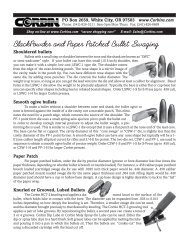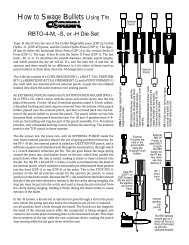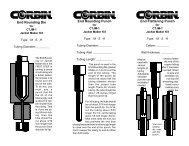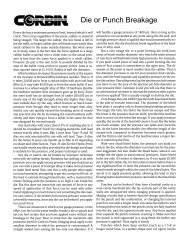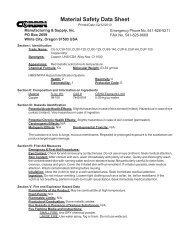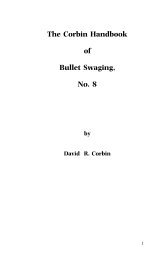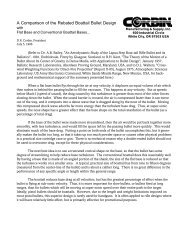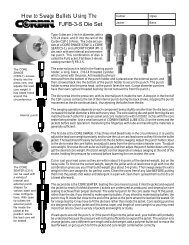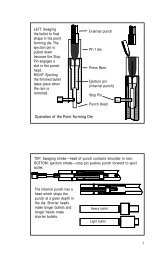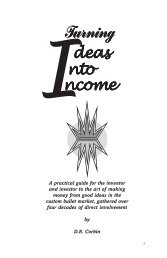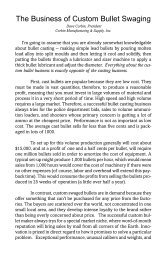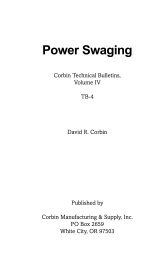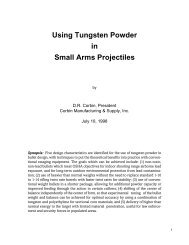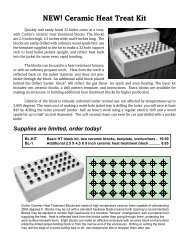HB-9 updated text (PDF) - Corbin Bullet Swaging
HB-9 updated text (PDF) - Corbin Bullet Swaging
HB-9 updated text (PDF) - Corbin Bullet Swaging
Create successful ePaper yourself
Turn your PDF publications into a flip-book with our unique Google optimized e-Paper software.
Mixing bullets that have eccentric weight variations into a group that<br />
has none will increase the group size. Mixing thin walled concentric jackets<br />
with thicker ones can change the group size only because the friction<br />
of the jackets as they pass through the bore may be different, so the powder<br />
burns a little differently, and the velocity may vary. This can cause the<br />
bullets to drop more or less depending on their velocity. The variation<br />
due only to difference in weight, meaning the gravitational drop, is so<br />
slight at 100 yards on a few grains (such as 2% or so of the bullet’s weight)<br />
that you can disregard it. You may as well talk about the effects of an<br />
airplane flying over and its gravitational pull shifting the bullet impact as<br />
the weight variation in a 2% or less situation.<br />
If you make your own bullets, and you have jackets that not only<br />
weigh the same but have walls that are the same on all sides, and you seat<br />
the lead cores to the same pressure so there is no loose core and no air<br />
pockets, then you will be able to ignore weight variations of less than 1%<br />
of total weight for any kind of shooting, and below 2% for anything but<br />
top level benchrest competition. Any weight variation in this range would<br />
be simply more or less core, concentric to the bullet center line, and would<br />
have no serious or noticeable effect on group size.<br />
If you have the same weight variation and it can be shown that the<br />
cause is eccentric walls or anything else that causes the weight to be<br />
shifted in an eccentric manner, then you will probably notice an increase<br />
in group size. So, weight variation is not an absolute measure of quality,<br />
but it is an indicator of a possible problem.<br />
Eccentric bullets are easy to make by putting a known weight of nylon<br />
string down one side of the jacket before swaging in the core—you<br />
can control the weight and position of the variation this way. We find the<br />
groups of bullets made with concentric weight variation (more or less<br />
core weight) are within the average size for the control bullets, whereas<br />
the eccentrics tend to fall outside in proportion to the amount of eccentricity.<br />
My point is that weight is not some absolute number that tells you<br />
“good” or “bad” about a bullet. After all, a 2 grain plus or minus variation<br />
on a 50 grain .224 is plus or minus 4% of the total weight and may have<br />
some noticeable effect, whereas the same variation on a 500 grain .458<br />
bullet is only 0.4% and is below the limit of accuracy of most electronic<br />
meters and chronographs, and is unlikely to have any affect that can be<br />
measured.<br />
Get out the instruction manual for any high precision digital scale,<br />
and you will probably find a “specifications” section that tells you the<br />
accuracy of the scale is from 1% to 5% of full scale reading, plus or minus<br />
the final digit. That is, if you are using a scale that goes to 500 grains, and<br />
43



